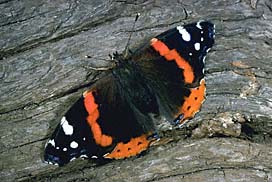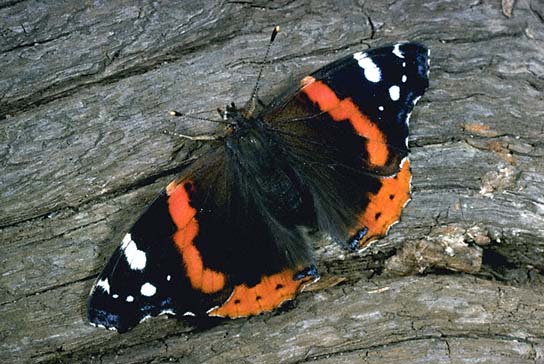Fritillaries and Orange Patterned Butterflies
Description
1 3/4-2 1/4" (44-57 mm). FW tip extended, clipped. Above, black with orange-red to vermilion bars across FW and on HW border. Below, mottled black, brown, and blue with pink bar on FW. White spots at FW tip above and below, bright blue patch on lower HW angle above and below.
Life Cycle
Egg greenish, barrel-shaped. Caterpillar, to 1 1/4" (32 mm), patterned light and dark from shiny black and yellow to brown and tan; warty and spiny. Chrysalis brown, gold-flecked; has dull short tubercles on thorax and curved abdomen. Nettles (Urtica) are best-known host plants, but other species in family Urticaceae used, such as pellitories (Parietaria), false nettles (Boehmeria), and hops (Humulus). Adults and chrysalises overwinter in mild areas.
Flight 2 broods in most of range; generally April or May-October, year-round in far South
Habitat
Forest margins and glades, rivers, shorelines; also barnyards, gardens, parks, roads; meadows, fields, and savannahs; open woods and clearings.
Range
Holarctic: in New World from subarctic Canada to Central America; naturalized in Hawaii
Discussion
Unmistakable and unforgettable, the Red Admiral will alight on a person's shoulder day after day in a garden. This species emigrates north in the spring, and there is some evidence of a dispersed return flight in the fall. If the season is mild, occasional individuals may pass a winter in the North; however, Red Admirals are not usually year-round residents in freezing climates. In midsummer it is not unusual to see them chasing each other or Painted Ladies just before a thunderstorm or at dusk. During the full sunshine hours, they are more likely to found quietly drinking from flowers or fruit.


